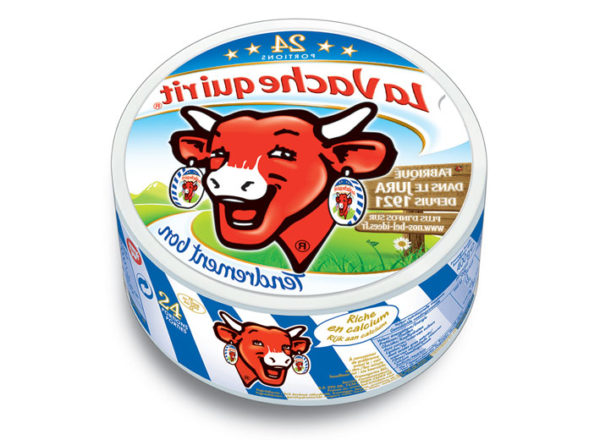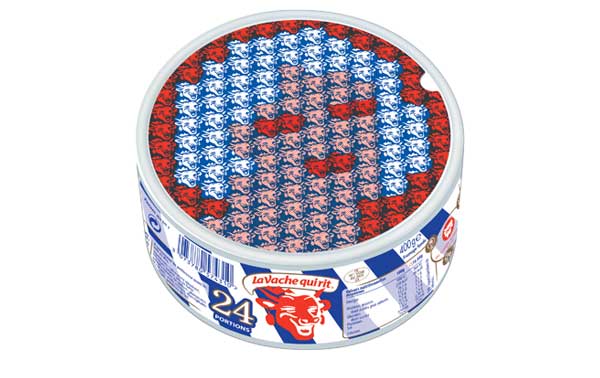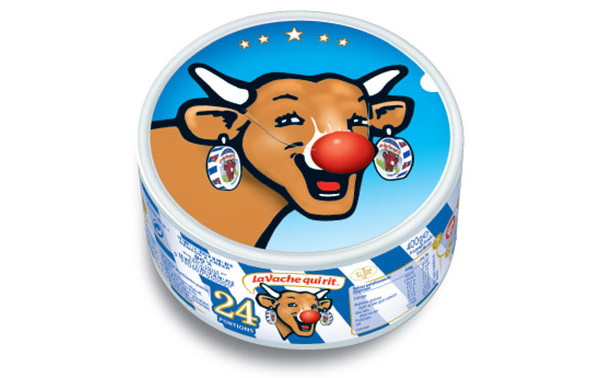What could be cheesier than associating the French with cheese? Very little. Yet, FIAC embraces the cliché by hosting Jonathan Monk—the Leicester-born artist has been invited to design a new packaging for La vache qui rit®, The Laughing Cow in English, bound to become the fair’s bestseller.
Forget about brie, camembert, comté, gruyère… all those regional treasures, which make France a haven of gastronomy. Sometimes we just don’t seem to appreciate our luck, our junk-filled fridges literally seeing red—as red as the countless Babybel and La vache qui rit packets crammed onto the shelves. What better way to pop from the supermarket aisles than with this attention grabbing colour? Marketed as a natural and convenient wax-wrapped round snack, the former brand was launched in France in the 1950s. The latter, created in 1921, is a blend of cream, milk and pasteurized cheeses. Which is the most popular? The battle exists outside the kitchen, where The Laughing Cow takes it all.
Far from being a laughing stock, Benjamin Rabier’s iconic character has inspired many artists over the years. Rather than being condemned for it, some have been invited to perpetuate this act of appropriation. The initiative ushers in a series of celebrations for the brand’s 100th anniversary, in 2021. This year, the responsibility falls upon British artist Jonathan Monk, within the framework of FIAC 2016.
Smile! The cow’s intriguing grin compels one to mimic her expression. Actually, is it a he or a she? Earrings are not exclusively reserved for women. This particular pair is rather meta, featuring themselves the face from which they hang. This double logo within the logo conveys the idea of resonating laughter, as well as an assembly-line. This neatly matches the position Jonathan Monk has taken since the beginning of his career. “Appropriation is something I have used or worked within my art since starting art school in 1987,” explains the forty-seven-year-old designer. “At the time—and still now—I realized that being original was almost impossible, so I tried using what was already available as source material for my own work.” This makes his reinterpretation of La vache qui rit that bit more subtle than that of his predecessors.
Contrary to Hans-Peter Feldmann and Thomas Bayrle, Monk has barely retouched the original picture. His intervention is hardly noticeable. He does not duplicate the logo using the model of Warhol’s Cow wallpaper, for example, nor does he cover the animal’s nose with a Babybel-looking red nose. He simply reverses the image, as if it were placed before a mirror. Whose reflection is it? The goofy animal’s? Unless the artist, by dint of hard work, ended up picturing himself as a mad cow.
The potential self-portrait is a limited edition. No wonder it is selling like hot (cheese) cakes. For 5 euros only, it must be the cheapest item in FIAC. It is also available for purchase in some Galeries Lafayette stores in Paris, Berlin, Marseille and Saint-Laurent-du-Var. The chain has been partners with FIAC for ten years. Such loyalty calls for a celebration this year.
Cheers to cheese and contemporary art!








